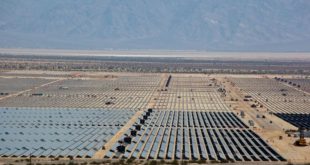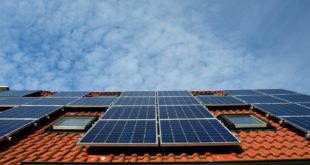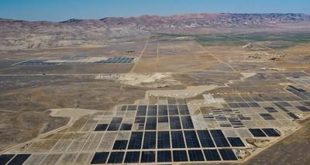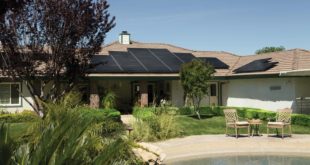Solar collectors
The key to solar collection is the solar cell, or photovoltaic (PV), fashioned from semiconducting materials such as silicon, much like computer chips. As this material absorbs light, negatively charged electrons break free of their atoms and flow, or conduct, through the material. Through conduction, these electrons—electricity—are transferred to a fluid-filled metal tube; this is usually made of copper or aluminum, both of which are good thermal conductors. The tubes are fill with air, water or a solution of water and glycol (antifreeze). The direct current (DC) produced passes through an inverter and emerges as alternating current (AC), which is then shunted to the utility panel to be distributed as 12- or 240-volt power for lights, appliances and outlets, as well as for domestic hot water heaters, swimming pools, radiators, radiant floor heating systems—even car washes.
Some industrial and commercial architects are beginning to add solar heating systems to warm up fresh air from outdoors before it is drawn into the building’s HVAC system, greatly reducing the amount of energy needed to heat the building conventionally.
Obviously, the percentage of your energy needs that you will be able to supply with a [tag-ice]solar [/tag-ice]collector system will depend on several factors, including the efficiency of the system you install, and where the building is located. Ideally this will be somewhere that experiences cold temperatures but that also receives plenty of sunlight; that way, even if it cannot supply everything necessary, it can at least reduce the need for traditional heating and electrical sources. Although they cost more, photovoltaic arrays that move to track the path of the sun help take advantage of as many hours of sunlight as possible. Many states offer tax credits, deductions, and sometimes sales or property tax exemptions for approved solar energy systems. If you are thinking of selling the house or structure any time soon, however, be aware that you may not qualify for a loan from many banks or other lenders unless you have some form of traditional system in place as a backup.
Solar Arrays
While small solar units can power such things as calculators and watches, to produce significant quantities of electricity photovoltaics are generally assembled into modules—self-contained in weather-resistant housings. The modules can easily be assembled into arrays of an appropriate size residential, commercial, scientific, and industrial installations.
The solar arrays of old were thick ungainly slabs of hardware, which made them unpopular with any but the most devoted enthusiasts. These days, however, solar arrays use a thin-film technology that allows them to be used in dozens of new ways, including as roof tiles and roof shingles that are as durable as traditional asphalt shingles but, of course, have the added benefit of doing more than keeping rain and snow out of the house. The efficiency has improved as well, although there is plenty of room for improvement. Although the first [tag]solar cells[/tag] had efficiencies of less than 5 percent (they have been around since the 1950s, believe it or not), today’s solar cells are still capable of converting only 15 percent of the sun’s rays to electricity.
This low efficiency is one reason that scientists have developed concentrating photovoltaic systems (CPVs). These use lenses or mirrors to focus more of the sun’s rays into a single area—hence the word concentrate—as well as to use less silicon-type materials, a costly part of the system, in favor of higher-performance conductors such as gallium arsenide. There are three types of CPVs to date:
§ Parabolic-trough systems—These use long U-shaped reflectors that focus the sunlight onto an oil-filled pipe in the center of the trough. The oil heats up, and can then be used to boil water to produce steam to turn a turbine.
§ Dish/engine systems—These look a little like satellite dishes. Again, they focus the rays onto a receptacle that heats a fluid. As the fluid heats, it expands and either moves a piston or a turbine.
§ Power tower system—This uses a large expanse of mirrors that focus the rays to a receiver on top of a tower. The receiver is filled with molten salt that, when heated, can power a conventional steam generator. Because molten salt holds onto heat for days, power tower systems can still be producing electricity even if the day is cloudy.
CPVs are not home-use systems. Because they are nearly always controlled by tracking systems to keep them aimed for maximum efficiency, they are used for large-scale solar plants—sun farms, in essence.
 Alternative Energy HQ solar power for homes, wind energy, and bio fuel issues
Alternative Energy HQ solar power for homes, wind energy, and bio fuel issues






